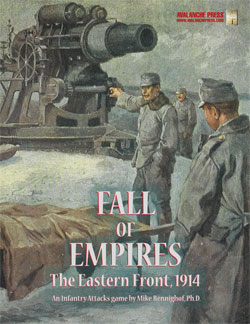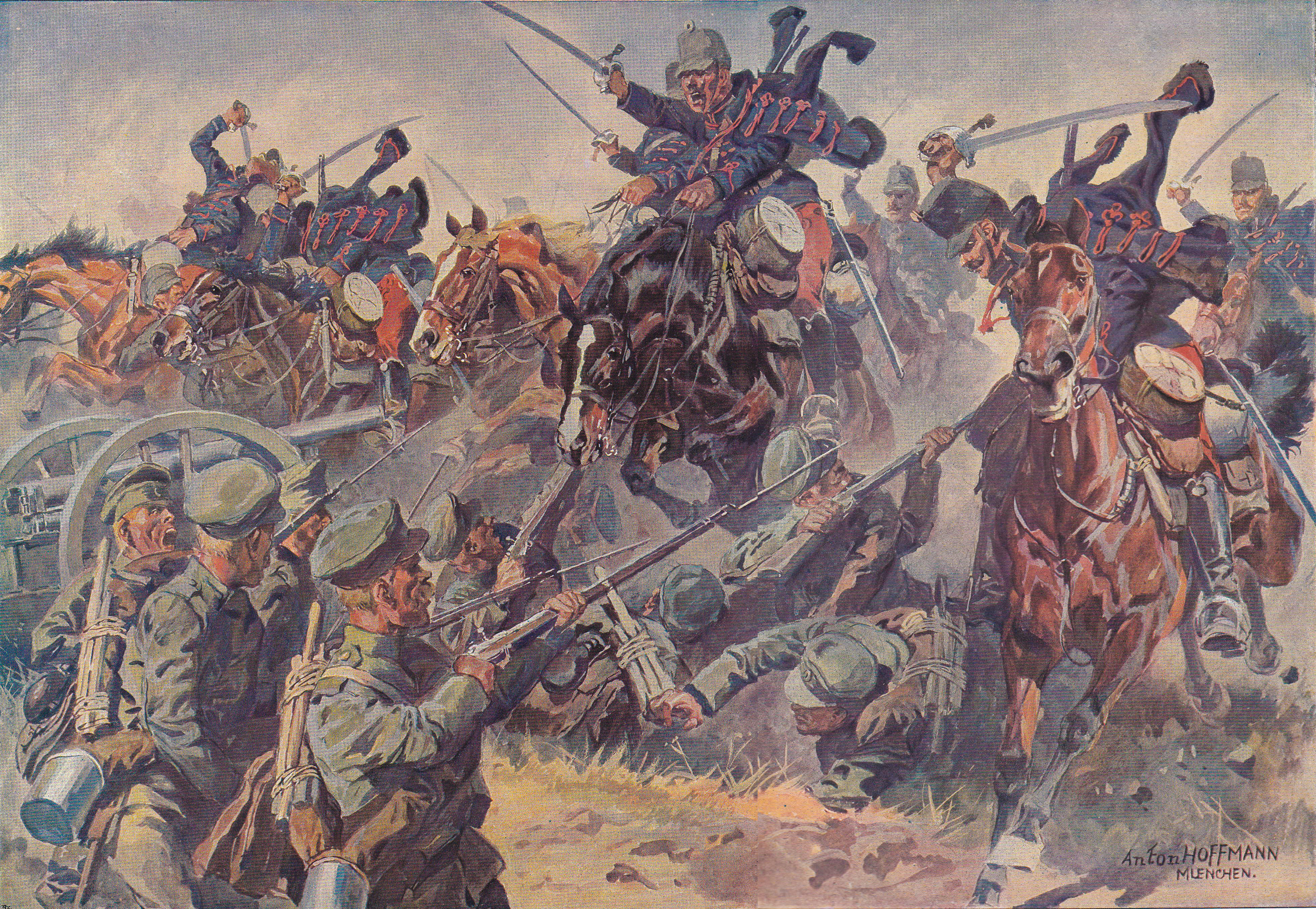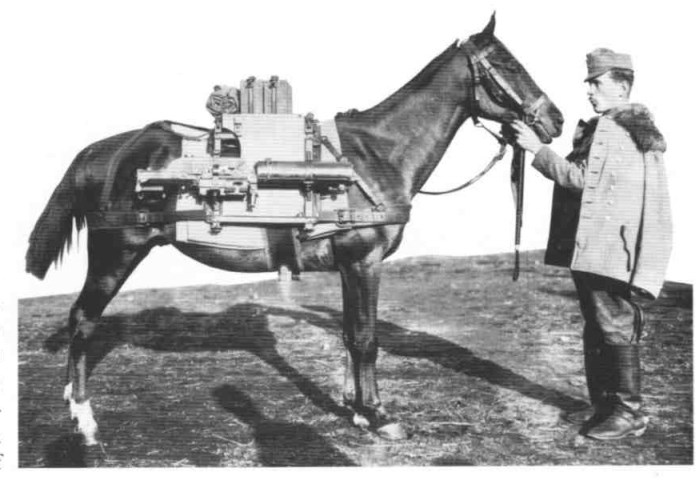| Fall of Empires/Franz Josef’s Armies
Austro-Hungarian Cavalry
By Mike Bennighof, Ph.D.
March 2022
 In 1914, the Austro-Hungarian cavalry retained its prestige both within the Common Army and in broader society. The most conservative arm of a most conservative army, the cavalry resisted most pre-war reforms and went into action some decades behind the state of the art. In 1914, the Austro-Hungarian cavalry retained its prestige both within the Common Army and in broader society. The most conservative arm of a most conservative army, the cavalry resisted most pre-war reforms and went into action some decades behind the state of the art.
While most popular histories of the First World War make a great deal of this point, it was less damaging than it might seem – everyone else’s cavalry was a generation or more out of date, too. There was still a place for horsed cavalry in the new century, but not in the same mold as the Napoleonic Wars.
The Austrian cavalry emerged from the 1866 Austro-Prussian and Austro-Italian wars with its reputation actually enhanced. The heavy cavalry had fought bravely and well to cover the retreat of the broken North Army after Königgrätz, while the light cavalry had shown enormous Bravour (meaning, in Austrian military parlance, a combination of initiative and courage) at Custoza, if not a great deal of effectiveness.
 Leopold von Edelsheim of 1st Light Cavalry Division was one of the few large unit commanders to have enjoyed unqualified success in the 1866 war, leading to his post-war appointment as Inspector-General of Cavalry. Edelsheim had dipped into his considerable private fortune to arm his division with repeating rifles, the only large Austrian unit with such weapons in 1866, and now he transformed the cavalry branch along the same lines. The heavy armored cavalry had already lost their breastplates in 1862, and now those regiments were transformed into generic light cavalry regiments – ulans, dragoons or hussars. All cavalrymen received a carbine, and trained in dismounted combat. The cavalry doctrine emphasized screening and scouting over mounted combat. Leopold von Edelsheim of 1st Light Cavalry Division was one of the few large unit commanders to have enjoyed unqualified success in the 1866 war, leading to his post-war appointment as Inspector-General of Cavalry. Edelsheim had dipped into his considerable private fortune to arm his division with repeating rifles, the only large Austrian unit with such weapons in 1866, and now he transformed the cavalry branch along the same lines. The heavy armored cavalry had already lost their breastplates in 1862, and now those regiments were transformed into generic light cavalry regiments – ulans, dragoons or hussars. All cavalrymen received a carbine, and trained in dismounted combat. The cavalry doctrine emphasized screening and scouting over mounted combat.
And there, things stagnated. As the Austro-Hungarian armed forces began a series of meaningful changes in the early years of the new century, the cavalry branch was led by Archduke Otto. The younger brother of heir Franz Ferdinand, Otto took up the post in 1904 but never actually performed his duties. Otto was well-known in Vienna for his huge flock of mistresses, and Otto quite famously had once arrived at Hotel Sacher, wearing only a cavalry saber, to visit a lady friend. Perhaps inevitably, Otto contracted syphilis and died in late 1906. His son (yes, Otto was married through all of this) would become Austria-Hungary’s last emperor, Karl I.
His successor as Inspector-General of Cavalry, Gen. Rudolf von Brudermann, may actually represent a step backward from Otto; at least the sybaritic archduke left Edelsheim’s principles in place. Brudermann resisted the reforms of Army chief of staff Franz Conrad von Hötzendorff, instead preaching a doctrine based on riding skills and swordcraft. Brudermann and his two younger brothers were noted as the best riders in the Austro-Hungarian cavalry, and so the new inspector-general put great emphasis on horsemanship.

Hungarian hussars attack at Kraśnik, Augusts 1914 (it didn’t happen this way).
When the rest of the army replaced its old-style dark blue uniform coats in 1907 in favor of pike-gray, Brudermann successfully fended off the change for his branch. They would continue to wear their dark blue over red trousers until late 1915. He was less successful extending the uniform to the new telegraph and machine-gun detachments added to cavalry regiments, also in 1907; they would wear pike-gray. Brudermann would remain as inspector general until August 1914, when he left to assume command of the Austro-Hungarian Third Army and lead it to devastating losses in the war’s first two months. Brudermann’s rejection of Conrad’s reforms did have one positive result for the Austro-Hungarian cavalry – unlike the infantry, they were trained to dig in when dismounted and under enemy fire. The problem came from a lack of entrenching tools; cavalrymen were expected to use their precious sabers instead.
Brudermann refused to re-clothe his troopers even as war became inevitable in the summer of 1914. The standard pike-gray uniforms, designed for war on the rocky slopes of the Alps (against Italy, putative ally), would have only been a marginal improvement over the dark blue. But Brudermann did assure that most of his troopers would receive brand-new saddles – assuring that many horses soon suffered from debilitating saddle sores when they were ridden for hundreds of kilometers under fresh leather than had not been broken in. Any teenaged groom would have known better, but Brudermann of course had never tacked up his own horse.
In August 1914, the Common Army fielded 42 cavalry regiments: 16 of Hussars, 15 of Dragoons and 11 of Ulans. Hussars came from the Kingdom of Hungary, Ulans from the Kingdom of Galicia and Lodomeria (Austrian Poland and Ukraine), and Dragoons from everywhere else in the Austrian half of the Monarchy.
 
They differed in uniform details, but all men carried a Mannlicher straight-pull M1895 carbine, a shortened version of the M95 Ruck-Zuck rifle of the infantry. It was substantially shorter and lighter than the infantry rifle, with no lugs for a bayonet – in dismounted close combat, cavalrymen were expected to use their sabers. This was the M1869 or M1877 cavalry sword, called a pallasch; to the considerable irritation of cavalry officers, this blade was also issued to the Vienna police department. In addition, troopers carried an M1907 Roth-Steyr semi-automatic pistol with a 10-round magazine.
The cavalry’s machine-gun detachments wielded the same Schwarzlose M7/12 heavy machine gun as the infantry. Where the infantry had mules to carry their machine guns, the cavalry of course had horses. At least before the war, the machine gunners were not seen as “real” cavalrymen and their officers were sent to the Rifle School for training; the Cavalry School did not sully itself with such things (it only trained riding instructors).
A cavalry regiment had six squadrons, each of 150 men, for a total of 900 troopers. Four regiments made up a cavalry division; the Common Army organized eight cavalry divisions. Each cavalry division also had a small artillery regiment with three horse artillery batteries (armed with the 8cm/M5 field gun), for a total of 18 pieces. That made for a very weak division: 3,600 carbines, eight machine guns and 18 field guns did not give a cavalry division the firepower to stand up to a Russian rifle regiment.

Honvéd hussars on the attack. Galicia, 1914. It didn’t happen this way, either.
The two national armies followed the same table of organization as the Common Army’s cavalry, and carried the same weapons (except that Landwehr Ulans had the Steyr M1912 semi-automatic pistol). The Imperial-Royal Landwehr, the regular army of the Austrian half of the monarchy, fielded six regiments of Ulans, though these were recruited from all over and not just Polish-Ukrainian districts. All of these regiments were broken up in August 1914 to provide the divisional cavalry (two squadrons each) for twelve Common Army and six Landwehr divisions. Despite what some sources claim, this was the only instance in the initial mobilization in which units of either national army were attached to Common Army divisions (or vice-versa).
The Royal Hungarian Honvédség, Hungary’s national army, fielded ten regiments of Hussars, and in addition 30 independent squadrons of Landsturm Hussars. Eight of the regular regiments formed two Honvéd Cavalry Divisions, while the other two were broken up to provide divisional cavalry squadrons for Honvéd infantry divisions. Unlike the Landwehr Ulans, the Honvéd Hussars were not assigned to Common Army divisions.
Finally, the Common Army raised a pair of traditional cavalry forces: two squadrons of Dalmatian Mounted Landesschützen, and three squadrons of Tirolean Mounted Landesschützen. The Mounted Landesschützen wore pike-gray, unlike the “real” cavalry; two Tirolean squadrons provided the cavalry for the independent 88th Landesschützen Brigade, while the third was attached to the 108th Landsturm Infantry Brigade. The Dalmatian squadrons were broken up into troops and assigned to four independent mountain brigades and two divisions operating in Bosnia.

Austro-Hungarian cavalry units had horses to carry their machine guns.
Cavalry regiments received their replacements from March battalions just like the infantry; unlike the infantry, these weren’t committed to combat separately from their parent regiment. However, these came to front far less frequently than their infantry counterparts, thanks to the far greater training needed for men and horses. The cavalry regiments therefore wore down quickly, particularly as horses were lost and highly-trained remounts became ever more difficult to obtain. More and more cavalry formations would be dismounted as the war progressed to fight as infantry though they retained their unit designations.
The cavalry’s performance in August 1914 brought mixed results. Conrad had planned a grand sweep by his cavalry, which ended in abject failure. The cavalry divisions simply lacked the strength to penetrate the Russian cavalry screen and bring back solid information on Russian dispositions. In the later stages of the campaign the cavalry fought well for the most part, and the squadrons attached to infantry divisions in particular gave very good service in performing scouting missions. But with few machine guns and little organic artillery, they had no place on the battlefield in division-sized formations.
A over one thousand years, when Austrian horsemen rode to war, each officer was attended by a horse-holder for the ceremonial ride – a wife, sister or sweetheart who held the bridle while he mounted. A knight needed a lady’s favor to enter battle. At garrisons across the Empire, young women put on their finest for what would be the tradition’s final act. Soon enough, most of them would trade those summer dresses for a widow’s black.
You can order Fall of Empires right here.
You can order Franz Josef's Armies right here.
Please allow an extra two weeks for delivery.
Sign up for our newsletter right here. Your info will never be sold or transferred; we'll just use it to update you on new games and new offers.
Mike Bennighof is president of Avalanche Press and holds a doctorate in history from Emory University. A Fulbright Scholar and NASA Journalist in Space finalist, he has published an unknowable number of books, games and articles on historical subjects.
He lives in Birmingham, Alabama with his wife, three children and his dog, Leopold. Leopold knows the number.
Want to keep Daily Content free of third-party ads? You can send us some love (and cash) through this link right here.
|
